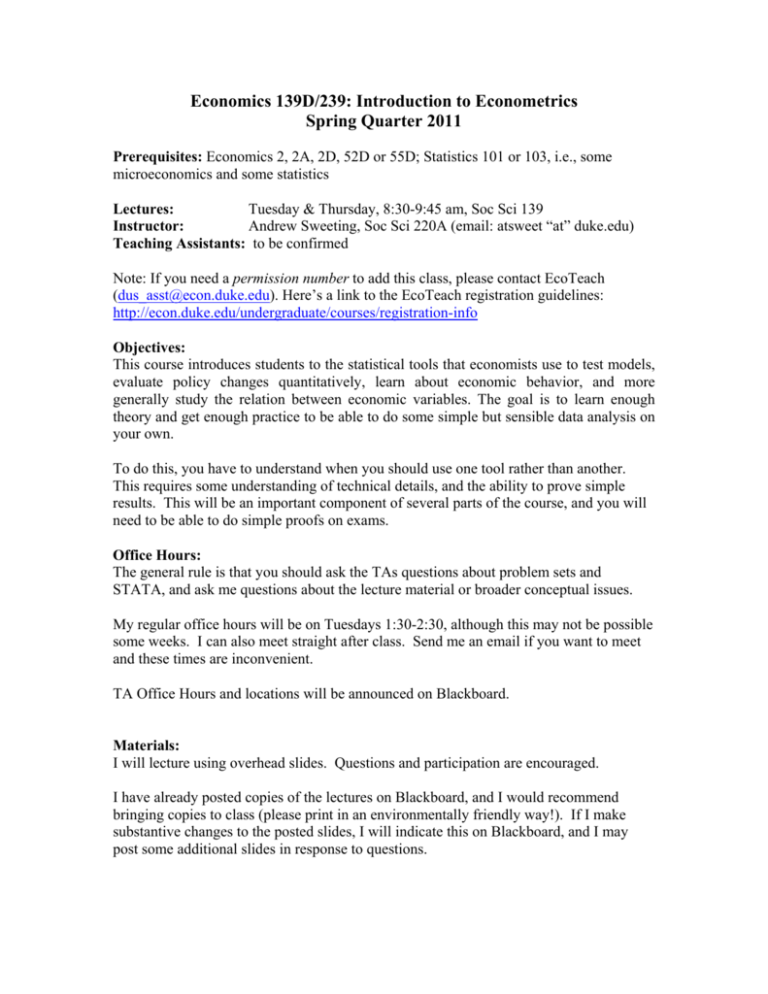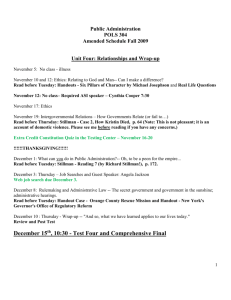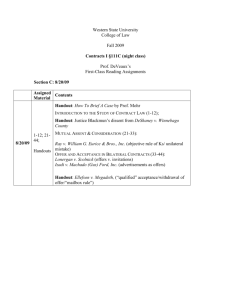Economics 139D/239: Introduction to Econometrics Spring Quarter
advertisement

Economics 139D/239: Introduction to Econometrics Spring Quarter 2011 Prerequisites: Economics 2, 2A, 2D, 52D or 55D; Statistics 101 or 103, i.e., some microeconomics and some statistics Lectures: Tuesday & Thursday, 8:30-9:45 am, Soc Sci 139 Instructor: Andrew Sweeting, Soc Sci 220A (email: atsweet “at” duke.edu) Teaching Assistants: to be confirmed Note: If you need a permission number to add this class, please contact EcoTeach (dus_asst@econ.duke.edu). Here’s a link to the EcoTeach registration guidelines: http://econ.duke.edu/undergraduate/courses/registration-info Objectives: This course introduces students to the statistical tools that economists use to test models, evaluate policy changes quantitatively, learn about economic behavior, and more generally study the relation between economic variables. The goal is to learn enough theory and get enough practice to be able to do some simple but sensible data analysis on your own. To do this, you have to understand when you should use one tool rather than another. This requires some understanding of technical details, and the ability to prove simple results. This will be an important component of several parts of the course, and you will need to be able to do simple proofs on exams. Office Hours: The general rule is that you should ask the TAs questions about problem sets and STATA, and ask me questions about the lecture material or broader conceptual issues. My regular office hours will be on Tuesdays 1:30-2:30, although this may not be possible some weeks. I can also meet straight after class. Send me an email if you want to meet and these times are inconvenient. TA Office Hours and locations will be announced on Blackboard. Materials: I will lecture using overhead slides. Questions and participation are encouraged. I have already posted copies of the lectures on Blackboard, and I would recommend bringing copies to class (please print in an environmentally friendly way!). If I make substantive changes to the posted slides, I will indicate this on Blackboard, and I may post some additional slides in response to questions. In class, we will work through some problems that are not in the lecture notes. Many of these will be from past exams. Handouts for discussion sections are also posted, and solutions will appear at the end of the relevant week. Problem sets are also posted. The schedule indicates which classes are related to each problem set. Textbook (highly recommended, not required): James Stock and Mark Watson, “Introduction to Econometrics” The latest edition (coming out just as we start to meet) is the 3rd edition. This can be purchased from the bookstore. There are two versions: one with a student version of STATA, the computer program we will be using, and one without. I believe that there is also a paperback version of the book. The book is excellent but quite expensive. If you do not want your own copy of STATA, a cheap copy of the 2nd edition is also fine as the text is almost identical, and all of the chapter references are the same. There’s a website with companion material. 2nd edition: http://wps.aw.com/aw_stock_ie_2/ 3rd edition: tba An alternative treatment is: Jeffrey M. Wooldridge (2003), “Introductory Econometrics,” Thomson/South-Western. NOTE: there will be some material in the textbook that we do not cover. The exams will be based on material covered in the lectures and obvious extensions. Software: We will be using the program Stata in the discussion sections and for homework assignments. Stata is available on the computers in 229 Social Sciences as well as in the Basement (Room 01) of the Old Chem Building. http://www.socsci.duke.edu/it/compute/stata.html Stata is updated frequently, although most things we will do should work fine on any version of Stata you will find on campus. I will use Stata 10 for anything I do in class. If you want, you can buy many different levels of STATA under their plan for students: http://www.stata.com/order/new/edu/gradplan.html I believe that Small STATA is the version that comes with Stock and Watson, Third Edition. Course Policies: Grading weights: Midterm 1 Midterm 2 Final 27.5% 27.5% 45% Grading will be on a curve. The historical median is a B. To avoid excess lobbying the exact grade cut-offs will not be announced. It is very rare for students to get a C- or worse if they attend the exams and make some effort. 1. There will be no makeup exams, and there are NO exceptions to this rule. If you miss the midterm, and you can document that you have a good excuse for missing the midterm, the weight of the missed exam will be placed on the final. By "having a good excuse" I mean that you will be required to submit adequate documentation to your Academic Dean, and cc me, justifying the reasons for your absence. This is in addition to the standard "short-term illness" e-mail. 2. The final is comprehensive (and you will see it could not be otherwise, given that everything we do after the midterm builds on pre-midterm material). 3. All exams will be closed books, but you will be allowed to use a cheat sheet that summarizes most results. Cheat sheets are available on Blackboard, but I will provide you with clean copies for each exam. 4. If you think that the midterm should be re-graded, you have to submit in writing the detailed reasons why you think this is the case. Take into account that if you ask for re-grading, the whole exam will be checked again. You have to submit requests for midterms’ re-grading within two weeks from the day the exams are returned (only adding errors will be corrected later). 5. Test grading: partial credit is always given for incomplete but partially correct answers. But you earn no credit if you leave a question blank or if what you write is completely incorrect or if it is just a re-statement of the question or in similar situations. Also, incorrect statements/steps do lose you points, even when your answer includes also the correct solution. 6. Class attendance is strongly encouraged, but it is not required. I know that 8:30AM is not a very “popular” time for an econometrics class, but 8:30AM is when we have been assigned to begin. Please arrive on time. 7. Problem sets will not count for your grade in the class. I will distribute problem sets for you to try to solve on your own every couple of weeks. These are not mandatory and will not be graded, but solutions will be made available as the term progresses. There are also a VERY LARGE number of practice problems with solutions that has been developed over the years and those are available on blackboard in a BIG .pdf file, which has been put together by various professors over the last seven or eight years. In advance of the first midterm we will go through last year’s midterm in class so that you can understand how the exam will be graded. If you spot any errors in the big .pdf file of past exams, please let me know, as it will help me, future instructors and current and future students. Course Outline Note: Dates are subject to change. Always check the problem sets for the correct due date. Chapter numbers refer to Stock and Watson (2nd edition, 3rd edition if different to 2nd). Handout numbers refer to the lecture notes on Blackboard. Problem set (PS) numbers indicate that the problem set covers material related to these lectures. Section numbers indicate the section handout related to the literature. Section #6 will focus on how to use STATA. Part 1: Statistics Review This section will be review for students with solid backgrounds in math and stats. However, it is very important to be comfortable with this material in order to do well in the rest of the course. Thursday January 13 Introduction, course description Statistics review: random variables; probability functions and distribution functions; expected value and variance (Chapter 2, Handout 1, PS #1, Section #1) Tuesday January 18 Statistics review: relationships between two random variables: marginals, joint, conditional; law of iterated expectations; correlation and independence. (Chapter 2, Handout 2, PS #1 & 2, Section #1) Thursday January 20 Statistics review: some important probability distributions; iid; estimators and estimates; example: sample mean (Chapters 2 and 3, Handout 3, PS #1 & 2, Section #2) Tuesday January 25 Statistics review: properties of estimators; bias, variance, Mean Squared Error, consistency, Asymptotic Normality; the Central Limit Theorem (Chapter 3, Handout 3, PS #2, Sections #2 and 3) Thursday January 27 Statistics review: Hypothesis tests and Confidence Intervals, p-values (Chapter 3, Handout 4, PS #2, Sections #2 and 3) Part 2: Basic Econometrics (Ordinary Least Squares) Tuesday Feb 1 Conditional expectations. Ordinary Least Squares (OLS) with only one conditioning variable. (Chapters 4 & 17, Handout 5, PS #3, Section #4) Thursday Feb 3 The OLS assumptions and properties of the estimators, sampling distribution (Chapters 4 & 17, Handout 6, PS #3, Section #4) Tuesday Feb 8 Tests and confidence intervals, Goodness of Fit & R-squared. (Chapters 4, 5, & 17, Handout 7, PS#3) Thursday Feb 10 Homoskedasticity vs Heteroskedasticity, Weighted Least Squares (Chapters 5 & 17, Handout 7, PS #4, Section #5) Tuesday Feb 15 Review of Midterm 1 2010 (this will be distributed in advance) General review slides will be posted on Blackboard Wednesday, Feb 16 Pre-midterm Q & A Time and location: tba (My plan will be to go through old exam/problem set questions which you are interested in – if possible send requests in advance) Thursday Feb 17 First Midterm Tuesday Feb 22 Omitted variables, introduction to multivariate OLS. (Chapters 6 and 18, Handout 8, PS #4, Section #7) Thursday Feb 24 Multivariate OLS, Assumptions and Properties. (Chapters 6 and 18, Handout 8, Section #7) Tuesday March 1 Imperfect multicollinearity, tests and confidence intervals for single coefficients, goodness of fit and adjusted R-squared. (Chapters 6, 7 and 18, Handout 8, PS #4, Section #7) Thursday March 3 Testing joint hypotheses (with and without homoskedasticity) (Chapters 6, 7 and 18, Handout 8, Sections #7 and 8) SPRING BREAK Tuesday March 15 Extensions to OLS: nonlinearities, estimation of elasticities, dummy variables and interactions. (Chapter 8, Handout 9, PS #5, Section #8) Thursday March 17 Nonlinearities (continued). (Chapter 8, Handout 9, PS #5, Section #8) Part 3: Beyond OLS Tuesday March 22 Regression with limited dependent variables; Linear probability model, logit and probit. (Chapter 11, Handout 10, PS #6, Section #9) Thursday March 24 Logit and probit; Maximum Likelihood Estimation (MLE) (Chapter 11, Handout 10, PS #6, Section #9) Tuesday March 29 Catch-up or Review MLE and limited dependent variables (Chapter 11, Handout 10, PS #6, Section #9) Wednesday March 30 Pre-midterm Q & A Time and location: tba Thursday March 31 Second Midterm Tuesday April 5 Linear models and panel data. (Chapter 10, Handout 11, PS #7, Section #10) Thursday April 7 Professor absent. A review session will likely be held during normal lecture time. Tuesday April 12 Endogenous regressors, simultaneity, and Instrumental Variables (Chapters 12 and 18, Handout 12, PS #8, Section #11) Thursday April 14 Two Stage Least Squares (2SLS) (Chapter 12 and 18, Handout 12, PS #8, Section #11) Tuesday April 19 Strength and Exogeneity (Chapter 12 and 18, Handout 12, PS #8, Section #11) Testing for Weak Instruments The Test of Over-identifying Restrictions 2SLS in Stata Thursday April 21 Experiments and Quasi-Experiments (Chapter 13, Handout 13, PS #9, Section #12) The Differences Estimator Tuesday April 26 The Differences-in-Differences Estimator (Chapter 13, Handout 13, PS #9, Section #12) Heterogeneous Effects Thursday May 5 Pre-final Q & A Time and location: tba The Final Exam is scheduled for Friday May 6th from 9am to noon.






